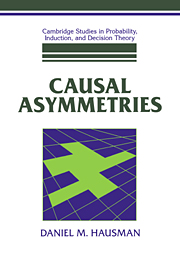Book contents
- Frontmatter
- Contents
- List of Figures
- Acknowledgments
- Introduction: Causation and its Asymmetries
- 1 Metaphysical Pictures and Wishes
- 1* Transfer Theories
- 2 Is Causation a Relation Among Events?
- 3 Causation, Regularities, and Time: Hume's Theory
- 4 Causation and Independence
- 4* Causation, Independence, and Causal Connection
- 5 Agency Theory
- 5* Causal Generalizations and Agency
- 6 The Counterfactual Theory
- 6* Independence and Counterfactual Dependence
- 7 Counterfactuals, Agency, and Independence
- 7* Agency, Counterfactuals, and Independence
- 8 Causation, Explanation, and Laws
- 8* Causation, Explanation, and Independent Alterability
- 9 Probabilistic Causation
- 10 Causation and Conditional Probabilities
- 10* Causal Graphs and Conditional Probabilistic Dependencies
- 11 Intervention, Robustness, and Probabilistic Dependence
- 11* Interventions and Conditional Probabilities
- 12 Operationalizing and Revising the Independence Theory
- 12* Probability Distributions and Causation
- 13 Complications and Conclusions
- Appendix A Alphabetical List of Propositions
- Appendix B List of Theorems
- References
- Index
11* - Interventions and Conditional Probabilities
Published online by Cambridge University Press: 20 April 2010
- Frontmatter
- Contents
- List of Figures
- Acknowledgments
- Introduction: Causation and its Asymmetries
- 1 Metaphysical Pictures and Wishes
- 1* Transfer Theories
- 2 Is Causation a Relation Among Events?
- 3 Causation, Regularities, and Time: Hume's Theory
- 4 Causation and Independence
- 4* Causation, Independence, and Causal Connection
- 5 Agency Theory
- 5* Causal Generalizations and Agency
- 6 The Counterfactual Theory
- 6* Independence and Counterfactual Dependence
- 7 Counterfactuals, Agency, and Independence
- 7* Agency, Counterfactuals, and Independence
- 8 Causation, Explanation, and Laws
- 8* Causation, Explanation, and Independent Alterability
- 9 Probabilistic Causation
- 10 Causation and Conditional Probabilities
- 10* Causal Graphs and Conditional Probabilistic Dependencies
- 11 Intervention, Robustness, and Probabilistic Dependence
- 11* Interventions and Conditional Probabilities
- 12 Operationalizing and Revising the Independence Theory
- 12* Probability Distributions and Causation
- 13 Complications and Conclusions
- Appendix A Alphabetical List of Propositions
- Appendix B List of Theorems
- References
- Index
Summary
Conditioning on a variable is not the same thing as intervening to fix the value of a variable, and the conditional probability of y given some particular value of x is not the same thing as the probability of y conditional on an intervention that “sets” this value of x. When one conditions, one takes as given the probability distribution. When one intervenes, one changes the probability distribution (but see pp. 229–30). These observations suggest a problem. The difference in the probability of b with and without an intervention that brings about a seems a surer guide to causal relations than does a comparison of Pr(B/A) and Pr(B/∼A). Do attempts to reduce causation to facts about probability distributions or merely to operationalize them in those terms rest on a confusion of conditional probabilities and probabilities given interventions? Do they collapse when this distinction is drawn? For example, suppose (as Ronald Fisher hypothesized) that tokens of smoking, s, and lung cancer, c, are related as effects of some common cause and not as cause and effect. In that case, even though Pr(C/S) > Pr(C/∼S), the probability of lung cancer is unaffected by interventions that bring about or prevent smoking. Following Pearl (1993, p. 267; 1995, p. 673), let us indicate the conditional probability that B will be instantiated given an intervention that brings about a token of kind a as Pr(B/set-A) and the conditional probability that y = y* given an intervention that causes the value of x to be x* as Pr(y=y*/set-x=x*) or less precisely as Pr(y/set-x).
- Type
- Chapter
- Information
- Causal Asymmetries , pp. 233 - 238Publisher: Cambridge University PressPrint publication year: 1998



